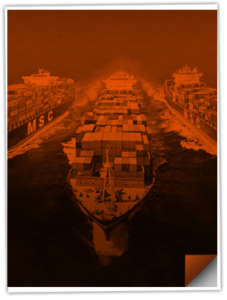Featured Headlines:
Is the ILA Gunfight Airtight or “Luddite?”
A Quick BIS & Boycott Request Pick-Me-Up
The Racey to Lacey Act Phase VII Implementation: Are You Ready?
FDA Dishes Out Third Course in Meal Series
Hurricane Misfortune Comes in Pairs
Sordid Sir Charge’s Morbid Rail Rates
CDL Crackdown on Seedy Violations
Is the ILA Gunfight Airtight or “Luddite?”
- The ILA had not gone on strike since 1977! That same year we said hello to Jimmy Carter and goodbye to Elvis. Apple began to make it big, and we were all glued to our TVs watching Roots. And, in New York, they caught the Son of Sam, suffered an infamous blackout, and danced beneath a strobe light at Studio 54.
- New York is also the home of the ILA’s leadership, and they scored an impressive 62% pay increase for the union to temporarily end the strike after only three days. Unfortunately, like Studio 54, this deal is only too cool for school for a short time.
- The contract extension ends on January 15th, and the ILA has not left us in the dark on their views on automation. It’s “one for the money, two for the show, no automation, no no no” for the ILA!
- For their part, the USMX is singing about suspicious minds saying, “why can you see, what’s you’re doing to me, when you don’t believe a word I say?”
- Not to be out staged, the Wall Street Journal essentially compared the ILA to the Luddite movement. For those who forgot, the Luddites set fire or destroyed textile machinery in the early 1800’s in England to protest the Industrial Revolution. Ouch, WSJ!
- The ILA believes that automation or even semi-automation can only lead to the destruction of jobs, the diminishment of jobs, and more profits for greedy foreign corporations.
- The USMX wants to know what they are getting for a 62% pay raise, and they profess that the ILA doth protest too much when automation not only creates jobs, it makes American ports more productive thus lowering consumer spending by lowering transportation costs.
- Most US and Gulf ports also have limited property for port development and increasingly robust local environmental regulations. Terminal owners SWEAR that automation promotes safety while lowering emissions (and authoring a meaningful US immigration policy). Wow, those robots are pretty darn smart, y’all!
- Speaking of robots and intelligence, MIT’s Daron Acemoglu indicates that, in other industries, six jobs are lost for every robot placed in service, and he believes that 700,000 jobs have been lost to date to automation. Score one for the ILA.
- A deeper look at the West Coast reveals that the owner of America’s one fully automated terminal, Long Beach Container Terminal (LBCT), has hired 13% more ILWU members in the last five years; this increase beats the heck out of the Port of New York’s increases.
- As part of their own recent contract negotiation, the ILWU is allowing the PMA to deploy semi-automation for the Middle Harbor Redevelopment Project.
- Total Terminals International’s project will combine the property of two crumbling Long Beach piers, E and T, into one modern, efficient terminal. It has yet to be announced if the automation will be limited to camera-support AI or robotic cranes as well. Frankly, this sounds like job creation via automation. Score one for USMX.
- Since we hope to enjoy our 110th year in business (and well beyond!), we shall not take sides here, but we can at least quote a few more Elvis songs!
- We don’t want to end up in the heartbreak hotel all shook up; we hope the two sides will have a little less conversation (in the press) while keeping the economy off jailhouse rock!
A Quick BIS & Boycott Request Pick-Me-Up
- The Department of Commerce’s Bureau of Industry and Security (BIS) published its second quarterly update of the Boycott Requester List on October 1st.
- This list notifies interested parties that there may be potential boycott-related requests.
- This does not mean that US citizens are prohibited from dealing with a listed party; but you should take precautions and double check your transactions with the listed party.
- BIS has removed 21 entities from the first list published and added 36 additional entities. Entities added had been previously identified and reported to BIS officials via a boycott-related request.
- For information regarding the application of the antiboycott regulations, please contact the OAC Advice Line at (202) 482-2381 or through the online portal.
- If you believe that you have been listed in error or would like to discuss a listing, please contact the Office of Antiboycott Compliance (OAC).
The Racey to Lacey Act Phase VII Implementation: Are You Ready?
- For anyone who might not have heard, the Animal and Plant Health Inspection Service (APHIS) will implement Phase VII of the Lacey Act on December 1, 2024.
- Phase VII will include a wide variety of materials and plant products that have not yet required a declaration. Importers of such items who do not currently file a Lacey Act declaration will likely need to file one once the APHIS begins implementing Phase VII.
- If you import wooden or plant products into the United States, you might be wondering if this change will affect you. Lucky for you, Shapiro is hosting an exclusive webinar this Thursday, October 17, 2024 at 2:00 PM (ET) to help you navigate the upcoming implementation.
- Register today to learn more about this program and the steps you need to take now to prepare for its implementation.
FDA Dishes Out Third Course in Meal Series
- The U.S. Food and Drug Administration (FDA) has released its third video in their “Importing FDA-Regulated Products” series.
- The third installment focuses on the process and key regulatory requirements for importing seafood.
- Here is the link to the video: Importing FDA-Regulated Products: Seafood.
- It’s import-ant to remember that import requirements of the National Marine Fisheries Service (NMFS) must also be met when importing seafood.
- Moral of the story… If something smells fishy, it probably is.
Hurricane Misfortune Comes in Pairs
- Just as Florida, Georgia, South Carolina, and especially North Carolina attempted to catch their breath from Helene, along came the menacing Milton to wreak havoc on Florida.
- Two weeks ago, Helene’s prolonged and heavy rains unleashed horrific flooding while claiming human lives, homes, pets, and people’s most-treasured items.
- From an infrastructure level, large pieces of I-26 and I-40 in North Carolina are simply gone—leaving shippers without their trusted routes for cargo and domestic expenses as much as double what they were just weeks ago.
- While the loss of life appears to be lower, Milton took aim at all aspects of logistics and supply chain management beginning at 8:30PM on October 9th at Siesta Key.
- Florida’s ports, quietly growing in size and significance, had to close with the Port of Tampa getting the worst of it.
- As residents had to flee, they consumed the available gasoline while truckers struggled to replenish fuel along damaged interstates with fleet staffs decimated by their own essential family evacuations.
- Significantly, the Port of Tampa handles 40% of the petroleum that enters the state of Florida. Keep a close eye on the massive tanks in Tampa; if they are not compromised, fuel should be able to flow back into Florida fairly quickly.
- At the risk of stating the (very) obvious, Florida is one giant peninsula. Its shape alone makes it vulnerable to overland supply route obstacles and emphasizes the significance of seaborne shipping.
- Imagine being a dray carrier with her last load before the storm. If she doesn’t run out of gas, she arrives at a warehouse that has closed early. Good luck taking that load back to the now closed port! Wait, is that a tornado on the horizon? Yes, yes it is.
- And, of course, Helene had already diminished available trucker labor and diverted assets and workers to support expedited deliveries of emergency relief goods and supplies. The one-two punch of Helene and Milton only multiplied the suffering and supply chain woes.
- Just to put a bitter cherry on these tragedies, let us not forget that Milton came on the heels of the port strike; the ports and harbors were brimming with cargo, readers.
- We have yet to learn how much cargo in warehouses was damaged during Milton’s extended violent lashing. Some people think bad news comes in threes; let us pray that those people are wrong this time.
Sordid Sir Charge’s Morbid Rail Rates
- Union Pacific Railroad (UP) announced that its VP of Pricing, Sir Charge, is riding the surcharge express to the fertile lands of higher profits!
- His train of thought is that current high volumes of discretionary cargo that usually arrive back East are “choo choo choosing” California often enough to impose a $750 per container extra fee from LA/LGB and $300 from Stockton or Oakland.
- As we track this story, it’s important to note that only small contract shippers or those without a contract at all must secure this extra “ticket to ride.” We always love to hear that the critical mass of giant shippers creates advantages at every possible crossroads!
- Our teasing the railroads is a bit off the rails; West Coast intermodal volumes are up over 15% this year, and recent import y-o-y gains for LA and Oakland near 25%.
- Chicago is a deep-dish grower with 25% more rail pie expected in October-November.
- While many shippers are not all aboard (!) with the fees, they will at least get their contracted volumes at contracted rates; the surcharges only apply to extra slots.
- These extra fees derail budgets, and they also derail any confidence shippers might have had that the West Coast can effectively absorb East/Gulf cargo for more than a week or so. The system is not broken, but these rails are already off the scales with freight!
CDL Crackdown on Seedy Violations
- Starting November 18, federal trucking regulators will require state licensing agencies to downgrade a driver’s commercial driver license (CDL) if the driver fails a drug or alcohol test and is placed on prohibited driving status.
- This is part of the Federal Motor Carrier Safety Administration’s (FMCSA) Drug & Alcohol Clearinghouse II, designed to prevent drivers from operating after receiving a drug or alcohol violation. The new rule builds on the existing Clearinghouse system established in 2020.
- State licensing agencies must remove commercial driving privileges for drivers with prohibited status until they complete the return-to-duty process, including substance abuse treatment, testing, and follow-up.
- States have 60 days to complete and record the CDL downgrade after receiving notification of a driver’s failed drug or alcohol test, entering the downgrade in the Commercial Driver’s License Information System.
- As of now, 177,000 drivers remain in prohibited driving status, with Texas leading the nation with 14,000 drivers in violation. Some states have taken action already, with Texas downgrading 7,000 CDLs.
- Drivers must complete several steps, including an evaluation by a certified substance abuse professional, undergoing treatment or education, passing a return-to-duty test, and participating in six random follow-up tests over 12 months.
- Regulators will conduct annual reviews to ensure state compliance, with potential funding penalties for non-compliant states.
- So far, no states have indicated they won’t comply with the new rules. Wait, different jurisdictions doing the right thing and uniting on principle??!! The FMCSA has also announced they will be providing training and guidance to US Congress!



